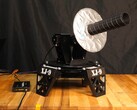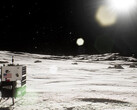The NSF-DOE Vera C. Rubin Observatory has begun operations with the world's largest 3,200-megapixel LSST CCD camera mounted in the Simonyi Survey Telescope to image the night sky from Cerro Pachón, Chile.
The project was funded by the U.S. National Science Foundation and U.S. Department of Energy’s Office of Science, and named after Dr. Vera C. Rubin, an American astronomer who worked on developing the concept of dark matter.
The car-sized LSST uses a grid of 201 CCD sensors with 10 micron pixels - 189 for imaging and the rest for control - to create a focal plane 64 cm wide that can capture the area of 45 moons at once (10 sq. deg.) with each two second exposure. The focal plane is cooled to -100 °C (-148 °F) to reduce the background noise in the 10 micron pixels.
The camera weighs 2,800 kg (6,000 lbs) and is mounted in the (199,580 kg) 220-ton Simonyi Survey telescope. A unique 8.4 meter mirror combines the function of the primary and tertiary mirrors by incorporating two different reflective curves. Light reflects between this mirror and the 3.4 m secondary mirror before reaching the LSST camera.
The entire telescope can be slewed to the next target in five seconds thanks to linear motors boosted by energy from capacitors, which recapture the energy to stop the telescope.
In front of the sensors, light passes through three lenses as large as 5.1 ft. (1.57 m) and as small as 27 in. (0.69 m) before reaching six swappable filters measuring 75 cm (30 in), allowing the camera to image light from the ultraviolet to near-infrared (320 to 1,050 nm). The shutter aperture takes 0.9 seconds to open, with a precision of 1/1000th second.
Each 3,200 MP image requires a grid of 400 4K monitors to display at 1-to-1 ratio, and each night, the Rubin Observatory will generate 20 TB of imaging data. The data is transferred over fiber optic cables from Chile to the SLAC National Accelerator Laboratory in Menlo Park, CA, CC-IN2P3 in Lyon, France, and Iris Network in the UK for data processing prior to release.
Readers can see the stars in their backyards with their own digital telescope from Amazon.





















